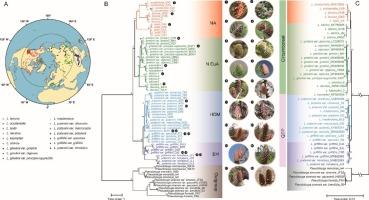系统发生组分析为全球落叶松的时空演变提供了新线索:对北方森林动态的影响。
IF 3.6
1区 生物学
Q2 BIOCHEMISTRY & MOLECULAR BIOLOGY
引用次数: 0
摘要
随着地球变暖,了解森林生态系统的长期动态对于指导森林管理和生物多样性保护至关重要。从过去的动态中获得的启示可能会为今天的森林管理提供宝贵的经验。在这里,我们研究了全球落叶松的时空演化,以进一步了解北方森林是如何随时间变化的。我们首先利用基于转录组的 1,301 个直向同源基因(OGs)和质体基因组,重建了一个高度解析和稳健的拉里克系统发育,涵盖了所有公认的物种。与之前的研究形成鲜明对比的是,我们的研究发现,在环周和青藏高原(QTP)落叶松之间出现了意想不到的深度分裂。在每一系中,又进一步分出了两个地理上不同的支系。生物地理学分析表明,落叶松可能起源于始新世的高纬度高地,在中新世出现了所有现存物种。新生代气候和造山运动引发的沧海桑田可能在全球落叶松的分化中扮演了重要角色。我们的研究结果还表明,原生林生物群落的起源可能要追溯到中新世早期,随着新近纪气候变得更加寒冷和干旱,原生林生物群落会发生重大的筛选和物种改变。生态位分析表明,在不同的气候情景下,环坡落叶松和QTP落叶松会有不同的反应,但这两个品系都会受到气候变暖的负面影响。鉴于北方森林对全球变暖的敏感性,这些发现对保护具有重要意义。我们的工作进一步强调了坚实的系统发生学框架对于进化和生物地理推断的重要性。本文章由计算机程序翻译,如有差异,请以英文原文为准。

Phylogenomic analyses shed new light on the spatiotemporal evolution of global larches: Implications for the dynamics of boreal forests
As the Earth warms, understanding the long-term dynamics of forest ecosystems is essential for guiding forest management and biodiversity conservation. Insights from past dynamics may provide valuable lessons for managing today’s forests. Here, we investigated the spatiotemporal evolution of global larches to gain further insights into how boreal forests change over time. We first reconstructed a highly resolved and robust phylogeny of Larix covering all widely recognized species, using both transcriptome-based 1,301 orthologous genes (OGs) and plastid genomes. In sharp contrast to previous studies, an unexpected deep split between the circumboreal and Qinghai-Tibetan Plateau (QTP) larches was revealed in our study. Within each lineage, two geographically distinct clades were further resolved. Biogeographical analyses suggest that Larix might have an origin of Eocene in high-latitude uplands, and during the Miocene, all extant species have appeared. Cenozoic climate- and orogeny-triggered vicariance likely played a major role in the divergence of global larches. Our results also demonstrate that the proto-boreal forest biome may have a relatively old origin back to the early Miocene, and significant winnowing and species alteration would have occurred as the climate shifted to much colder and drier conditions during the Neogene. Ecological niche analyses show various responses of the circumboreal and QTP larches under different climate scenarios, but both lineages are negatively impacted by warming climates. These findings have important conservation implications given the sensitivity of boreal forests in the face of global warming. Our work further emphasizes the importance of a solid phylogenetic framework for evolutionary and biogeographical inferences.
求助全文
通过发布文献求助,成功后即可免费获取论文全文。
去求助
来源期刊
CiteScore
7.50
自引率
7.30%
发文量
249
审稿时长
7.5 months
期刊介绍:
Molecular Phylogenetics and Evolution is dedicated to bringing Darwin''s dream within grasp - to "have fairly true genealogical trees of each great kingdom of Nature." The journal provides a forum for molecular studies that advance our understanding of phylogeny and evolution, further the development of phylogenetically more accurate taxonomic classifications, and ultimately bring a unified classification for all the ramifying lines of life. Phylogeographic studies will be considered for publication if they offer EXCEPTIONAL theoretical or empirical advances.

 求助内容:
求助内容: 应助结果提醒方式:
应助结果提醒方式:


